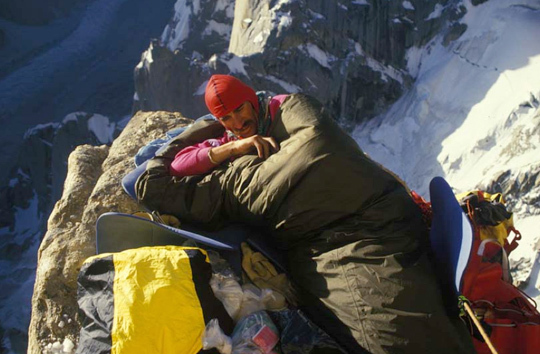
Erhard Loretan on the the first ascent of the Swiss-Polish Route on the Nameless Tower. Loretan was the third man to climb all fourteen 8000m peaks, and was responsible for such milestones as his and Jean Troillet’s fifteen-hour blast of the north face of Mt. Everest, a feat that included a five-hour glissade back to the base of the mountain. [Photo] Voytek Kurtyka
Erhard Loretan died while guiding in the Bernese Alps of his homeland, Switzerland, on April 28. Throughout his climbing career Loretan has been at the forefront of hard ascents in light and fast alpine style.
The accident occurred on his 52nd birthday at around 3800m up the summit ridge of Grunhorn (4043m). Loretan and his partner fell some 200 meters. Weather inhibited immediate rescue by air delaying the rescue until a team could ski into the area. Rescuers found Loretan dead and his client in serious conditions. She was flown out and remains in serious condition but conscious.
Climbing was always a central part of Loretan’s life. Born in Bulle at the foot of the Alps, he began climbing at age 11. His serious climbing career began in the early 80s when he set up new routes in the Andes and became a mountain guide. In 1982 Loretan climbed Nanga Parbat, his first 8000m peak. Over the next 13 years he would climb the other thirteen peaks over 8000m, becoming the third to do so and the second to do so without supplemental oxygen.
Steve House wrote in the 2000 American Alpine Journal about the last major breakthrough in alpinism, crediting it in part to Loretan.
“Historically, the best barometer of the state of climbing has been alpinism. And the last
stylistic climax in alpine climbing came in the mid- to late 1980s when many of the 8000-
meter peaks were climbed in single-push style, often by new routes. Such climbing was
termed “night-naked” by Voytek Kurtyka; he, Jean Troillet, Pierre-Allain Steiner and Erhard
Loretan were at the center of adapting this bivouac-less style to the peaks of the Himalaya.”
Three of those 8000m peaks, Gasherbrum II (8035m), Gasherbrum I (8068m) and Broad Peak (8091m) were completed in only 17 days. The next year, in 1984, he did a first ascent of the east ridge of Annapurna (8091m) with Norbert Joost. In the following winter Loretan did a first winter ascent of the East Face of Dhaulagiri (8167m). An ascent that was hailed as a return to the essence and good taste of mountaineering. Achievements and disasters occurred in 1986 when Loretan completed the “imperial crown”, 38 peaks in the Valese Alps in 19 days. This was followed by a fast alpine style ascent and descent of Everest (8848m) via the Hornbein couloir in 43 hours with Jean Troillet. Later he was quoted “We didn’t intend to climb Everest in two days, we just set off and we were fortunate to do it in two days.”
Disaster struck in an attempt on the southwest face of Cho Oyu (8201m) in which his climbing partner, Pierre-Alain Steiner, died. Years later Loretan returned to Cho Oyu and completed the first ascent of the southwest face. Only days later a first ascent of the south face of Shisha Pangma (8046m) followed.
An interview between Loretan and Voytek Kurtyka published in Issue 121 of Mountain Magazine reads as follows.
“VK ‘Do you train for your climbs?’
EL ‘No, the best training is here,’ tapping his forehead.
VK ‘Do you smoke or drink?’
EL “No to the first, yes to the second.”
VK ‘Any medications taken?’
EL ‘Only mild sleeping pills, never anything to improve blood supply.’
VK ‘What do you want most in high altitude mountaineering?’
EL ‘As difficult, high and quick as possible, alpine style of course.'”
Many more ascents are included in his climbing curriculum, until in 1998, when he chose to shift his focus to sharing his love with the mountains as a mountain guide. Of his more active days Loretan summarized: “I think we were young, in love with climbing. When you’re in love you’ll do anything, it wasn’t a sacrifice […]. We didn’t think we were doing incredible things, it just all seemed normal.”